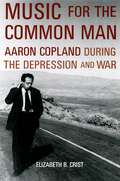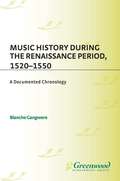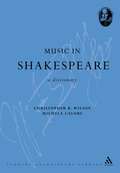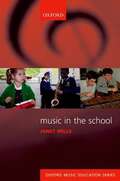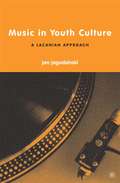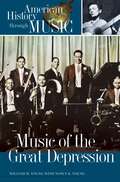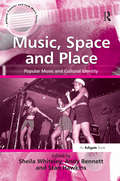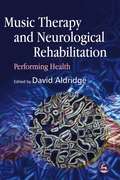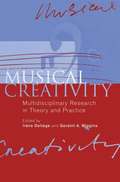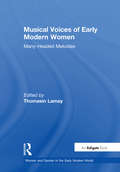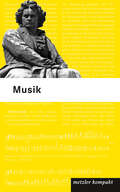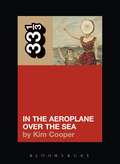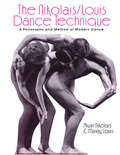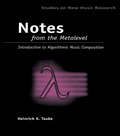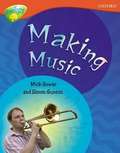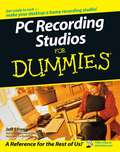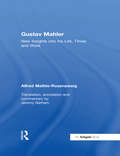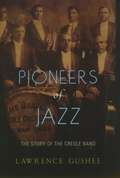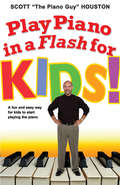- Table View
- List View
Music for the Common Man: Aaron Copland during the Depression and War
by Elizabeth B. CristIn the 1930s, Aaron Copland began to write in an accessible style he described as "imposed simplicity." Works like El Salón México, Billy the Kid, Lincoln Portrait, and Appalachian Spring feature a tuneful idiom that brought the composer unprecedented popular success and came to define an American sound. Yet the cultural substance of that sound--the social and political perspective that might be heard within these familiar pieces--has until now been largely overlooked. While it has long been acknowledged that Copland subscribed to leftwing ideals, Music for the Common Man is the first sustained attempt to understand some of Copland's best-known music in the context of leftwing social, political, and cultural currents of the Great Depression and Second World War. Musicologist Elizabeth Crist argues that Copland's politics never merely accorded with mainstream New Deal liberalism, wartime patriotism, and Communist Party aesthetic policy, but advanced a progressive vision of American society and culture. Copland's music can be heard to accord with the political tenets of progressivism in the 1930s and '40s, including a fundamental sensitivity toward those less fortunate, support of multiethnic pluralism, belief in social democracy, and faith that America's past could be put in service of a better future. Crist explores how his works wrestle with the political complexities and cultural contradictions of the era by investing symbols of America--the West, folk song, patriotism, or the people--with progressive social ideals. Much as been written on the relationship between politics and art in the 1930s and '40s, but very little on concert music of the era. Music for the Common Man offers fresh insights on familiar pieces and the political context in which they emerged.
Music History During the Renaissance Period, 1520-1550: A Documented Chronology (Music Reference Collection)
by Blanche M. GangwereThis annotated chronology of western music is the third in a series of outlines on the history of music in western civilization. It contains a 120-page annotated bibliography, followed by a detailed, documented outline that is divided into ten chapters. Each chapter is written in chronological order with every line being documented by means of abbreviations that refer to the annotated bibliography. There are short biographies of the theorists and detailed discussions of their works. The information on music is organized by classes of music rather than by composer. Also included are lists of manuscripts with descriptions of their contents and notations as to where they may be found. The material for the outline has been taken from primary and secondary sources along with articles from periodicals.Like the other two volumes in this series, Music History from the Late Roman through the Gothic Periods, 313-1425 and Music History During the Renaissance Period, 1425-1520, this volume will be an important research tool for anyone interested in music history.
Music in Shakespeare: A Dictionary (Continuum Shakespeare Dictionaries)
by Christopher R. Wilson Michela CaloreMusical references, allusions to music, and music stage directions abound in Shakespeare, ranging from simple trumpet flourishes to sophisticated, philosophical allegory. Music in Shakespeare: A Dictionary identifies all musical terms found in the Shakespeare canon. An A-Z of over 300 entries includes a definition of each musical term in its historical and theoretical context, and explores the extent of Shakespeare's use of musical imagery across the full range of his dramatic and poetic work. Music in Shakespeare also analyses the usage of musical instruments and sound effects on the Shakespearean stage, providing descriptions of the instruments employed in the Elizabethan and Jacobean theatres. This is a comprehensive reference guide for scholars and students with interests ranging from the thematic and allegorical relevance of music in Shakespeare's works to the history of performance. It is also aimed at the growing number of directors and actors concerned with recovering the staging conditions of the early modern theatre.
Music in the School: (pdf)
by Janet MillsHow do some schools get music so right while others get it so wrong? Janet Mills, a former HMI and teacher, draws on work in more than 800 schools and published research as she seeks to help schools improve their practice - no matter how good it is already. Successful teaching, she argues, is creative, uplifting, enabling, and, above all, rooted in music. The aim of this book is to 'Put the music back into music'.Thought-provoking, challenging, and empowering, this book is an essential read for all those interested in music in schools, including class teachers, instrumental teachers, and researchers. Using informative and entertaining examples and anecdotes, Janet Mills criticizes notions such as 'musical children' and 'musical schools', and comments on the roles of instrumental teachers and so-called 'non-specialists'. She explores how music in school can, and must, interact with music out of school, and considers how to measure progress in music - and how not to. Music in the School is not a step-by-step guide to better teaching, but rather a springboard for consideration, reflection, and action. Anyone who cares about music at school will find this book a powerful tool.
Music in Youth Culture: A Lacanian Approach
by j. jagodzinskiMusic in Youth Culture examines the fantasies of post-Oedipal youth cultures as displayed on the landscape of popular music from a post-Lacanian perspective. Jan Jagodzinski, an expert on Lacan, psychoanalysis, and education's relationship to media, maintains that a new set of signifiers is required to grasp the sliding signification of contemporary 'youth'. He discusses topics such as the figurality of noise, the perversions of the music scene by boyz/bois/boys and the hysterization of it by gurlz/girls/grrrls. Music in Youth Culture also examines the postmodern 'fan (addict)', techno music, and pop music icons. Jagodzinski raises the Lacanian question of 'an ethics of the Real' and asks educators to re-examine 'youth' culture.
Music of the Great Depression (American History through Music)
by William H. Young Nancy K. YoungPrior to the stock market crash of 1929 American music still possessed a distinct tendency towards elitism, as songwriters and composers sought to avoid the mass appeal that critics scorned. During the Depression, however, radio came to dominate the other musical media of the time, and a new era of truly popular music was born. Under the guidance of the great Duke Ellington and a number of other talented and charismatic performers, swing music unified the public consciousness like no other musical form before or since. At the same time the enduring legacies of Woody Guthrie in folk, Aaron Copeland in classical, and George and Ira Gershwin on Broadway stand as a testament to the great diversity of tastes and interests that subsisted throughout the Great Depression, and play a part still in our lives today. The lives of these and many other great musicians come alive in this insightful study of the works, artists, and circumstances that contributed to making and performing the music that helped America through one of its most difficult times.The American History through Music series examines the many different styles of music that have played a significant part in our nation's history. While volumes in this series show the multifaceted roles of music in our culture, they also use music as a lens through which readers may study American social history. The authors present in-depth analysis of American musical genres, significant musicians, technological innovations, and the many connections between music and the realms of art, politics, and daily life.
Music, Space and Place: Popular Music and Cultural Identity
by Andy BennettMusic, Space and Place examines the urban and rural spaces in which music is experienced, produced and consumed. The editors of this collection have brought together new and exciting perspectives by international researchers and scholars working in the field of popular music studies. Underpinning all of the contributions is the recognition that musical processes take place within a particular space and place, where these processes are shaped both by specific musical practices and by the pressures and dynamics of political and economic circumstances. Important discourses are explored concerning national culture and identity, as well as how identity is constructed through the exchanges that occur between displaced peoples of the world's many diasporas. Music helps to articulate a shared sense of community among these dispersed people, carving out spaces of freedom which are integral to personal and group consciousness. A specific focal point is the rap and hip hop music that has contributed towards a particular sense of identity as indigenous resistance vernaculars for otherwise socially marginalized minorities in Cuba, France, Italy, New Zealand and South Africa. New research is also presented on the authorial presence in production within the domain of the commercially driven Anglo-American music industry. The issue of authorship and creativity is tackled alongside matters relating to the production of musical texts themselves, and demonstrates the gender politics in pop. Underlying Music, Space and Place, is the question of how the disciplines informing popular music studies - sociology, musicology, cultural studies, media studies and feminism - have developed within a changing intellectual climate. The book therefore covers a wide range of subject matter in relation to space and place, including community and identity, gender, race, 'vernaculars', power, performance and production.
Music, Space and Place: Popular Music and Cultural Identity (Ashgate Popular And Folk Music Ser.)
by Andy BennettMusic, Space and Place examines the urban and rural spaces in which music is experienced, produced and consumed. The editors of this collection have brought together new and exciting perspectives by international researchers and scholars working in the field of popular music studies. Underpinning all of the contributions is the recognition that musical processes take place within a particular space and place, where these processes are shaped both by specific musical practices and by the pressures and dynamics of political and economic circumstances. Important discourses are explored concerning national culture and identity, as well as how identity is constructed through the exchanges that occur between displaced peoples of the world's many diasporas. Music helps to articulate a shared sense of community among these dispersed people, carving out spaces of freedom which are integral to personal and group consciousness. A specific focal point is the rap and hip hop music that has contributed towards a particular sense of identity as indigenous resistance vernaculars for otherwise socially marginalized minorities in Cuba, France, Italy, New Zealand and South Africa. New research is also presented on the authorial presence in production within the domain of the commercially driven Anglo-American music industry. The issue of authorship and creativity is tackled alongside matters relating to the production of musical texts themselves, and demonstrates the gender politics in pop. Underlying Music, Space and Place, is the question of how the disciplines informing popular music studies - sociology, musicology, cultural studies, media studies and feminism - have developed within a changing intellectual climate. The book therefore covers a wide range of subject matter in relation to space and place, including community and identity, gender, race, 'vernaculars', power, performance and production.
Music Therapy and Neurological Rehabilitation: Performing Health (PDF)
by Anke Scheel-Sailer David Aldridge Hanne Mette Ridder Ochsner Simon GilbertsonThe central tenet of this innovative collection is that identity can be regarded as a performance, achieved through and in dialogue with others. The authors show that where neuro-degenerative disease restricts movement, communication and thought processes and impairs the sense of self, music therapy is an effective intervention in neurological rehabilitation, successfully restoring the performance of identity within which clients can recognise themselves. It can also aid rehabilitation of clients affected by dementia, traumatic brain injury, and multiple sclerosis, among other neuro-generative diseases. Music Therapy and Neurological Rehabilitation is an authoritative and comprehensive text that will be of interest to practising music therapists, students and academics in the field.
Musical Creativity: Multidisciplinary Research In Theory And Practice (PDF)
by Irène Deliège Geraint A. WigginsThis collection initiates a resolutely interdisciplinary research dynamic specifically concerning musical creativity. Creativity is one of the most challenging issues currently facing scientific psychology and its study has been relatively rare in the cognitive sciences, especially in artificial intelligence. This book will address the need for a coherent and thorough exploration. Musical Creativity: Multidisciplinary Research in Theory and Practicecomprises seven sections, each viewing musical creativity from a different scientific vantage point, from the philosophy of computer modelling, through music education, interpretation, neuroscience, and music therapy, to experimental psychology. Each section contains discussions by eminent international specialists of the issues raised, and the book concludes with a postlude discussing how we can understand creativity in the work of eminent composer, Jonathan Harvey. This unique volume presents an up-to-date snapshot of the scientific study of musical creativity, in conjunction with ESCOM (the European Society for the Cognitive Sciences of Music). Describing many of the different aspects of musical creativity and their study, it will form a useful springboard for further such study in future years, and will be of interest to academics and practitioners in music, psychology, cognitive science, artificial intelligence, neuroscience and other fields concerning the study of human cognition in this most human of behaviours.
Musical Voices of Early Modern Women: Many-Headed Melodies (Women and Gender in the Early Modern World)
by Thomasin LaMayRecent scholarship has offered a veritable landslide of studies about early modern women, illuminating them as writers, thinkers, midwives, mothers, in convents, at home, and as rulers. Musical Voices of Early Modern Women adds to the mix of early modern studies a volume that correlates women's musical endeavors to their lives, addressing early modern women's musical activities across a broad spectrum of cultural events and settings. The volume takes as its premise the notion that while women may have been squeezed to participate in music through narrower doors than their male peers, they nevertheless did so with enthusiasm, diligence, and success. They were there in many ways, but as women's lives were fundamentally different and more private than men's were, their strategies, tools, and appearances were sometimes also different and thus often unstudied in an historical discipline that primarily evaluated men's productivity. Given that, many of these stories will not necessarily embrace a standard musical repertoire, even as they seek to expand canonical borders. The contributors to this collection explore the possibility of a larger musical culture which included women as well as men, by examining early modern women in "many-headed ways" through the lens of musical production. They look at how women composed, assuming that compositional gender strategies may have been used differently when applied through her vision; how women were composed, or represented and interpreted through music in a larger cultural context, and how her presence in that dialog situated her in social space. Contributors also trace how women found music as a means for communicating, for establishing intellectual power, for generating musical tastes, and for enhancing the quality of their lives. Some women performed publicly, and thus some articles examine how this impacted on their lives and families. Other contributors inquire about the economics of music and women, and how in different situations some women may have been financially empowered or even in control of their own money-making. This collection offers a glimpse at women from home, stage, work, and convent, from many classes and from culturally diverse countries - including France, Spain, Italy, England, Austria, Russia, and Mexico - and imagines a musical history centered in the realities of those lives.
Musical Voices of Early Modern Women: Many-Headed Melodies (Women and Gender in the Early Modern World)
by Thomasin LamayRecent scholarship has offered a veritable landslide of studies about early modern women, illuminating them as writers, thinkers, midwives, mothers, in convents, at home, and as rulers. Musical Voices of Early Modern Women adds to the mix of early modern studies a volume that correlates women's musical endeavors to their lives, addressing early modern women's musical activities across a broad spectrum of cultural events and settings. The volume takes as its premise the notion that while women may have been squeezed to participate in music through narrower doors than their male peers, they nevertheless did so with enthusiasm, diligence, and success. They were there in many ways, but as women's lives were fundamentally different and more private than men's were, their strategies, tools, and appearances were sometimes also different and thus often unstudied in an historical discipline that primarily evaluated men's productivity. Given that, many of these stories will not necessarily embrace a standard musical repertoire, even as they seek to expand canonical borders. The contributors to this collection explore the possibility of a larger musical culture which included women as well as men, by examining early modern women in "many-headed ways" through the lens of musical production. They look at how women composed, assuming that compositional gender strategies may have been used differently when applied through her vision; how women were composed, or represented and interpreted through music in a larger cultural context, and how her presence in that dialog situated her in social space. Contributors also trace how women found music as a means for communicating, for establishing intellectual power, for generating musical tastes, and for enhancing the quality of their lives. Some women performed publicly, and thus some articles examine how this impacted on their lives and families. Other contributors inquire about the economics of music and women, and how in different situations some women may have been financially empowered or even in control of their own money-making. This collection offers a glimpse at women from home, stage, work, and convent, from many classes and from culturally diverse countries - including France, Spain, Italy, England, Austria, Russia, and Mexico - and imagines a musical history centered in the realities of those lives.
Musik
by Ralf NoltensmeierVon Akkord bis Zwölftonmusik, von Aufführungspraxis bis Walzer - die wichtigsten Begriffe, Fakten und Definitionen zur klassischen und populären Musik in 250 Einträgen. Musikalische Gattungen von der Oper bis zum Jazz-Stil sind ebenso vertreten wie die grundlegenden Begriffe der Musiktheorie und Harmonielehre.
Neutral Milk Hotel's In the Aeroplane Over the Sea (33 1/3)
by Kim CooperOf all the recordings to emerge from the Athens-via-Denver collective called Elephant 6, Neutral Milk Hotel's second album is the one that has worked its way under the most skins. Magnet magazine named it the best album of the 1990s, and Creative Loafing recently devoted a cover story to one fan's quest to understand why band leader Jeff Mangum dropped outof sight soon after Aeroplane's release. The record sells steadily to an audience that finds it through word of mouth. Weird, beautiful, absorbing, difficult, In The Aeroplane Over the Seais a surrealist text loosely based on the life, suffering and reincarnation of Anne Frank, with guest appearances from a pair ofSiamese twins menaced by the cold and carnivores, a two-headed boy bobbing in a jar, anthropomorphic vegetables and a variety of immature erotic horrors. Mangum sings his dreamlike narratives with a dreamer's intensity, his creaky, off key voice occasionally breaking as he struggles to complete each dense couplet. The music is like nothing else in the 90s indie underground: a psychedelic brass band, its members self-taught, forging polychromatic washes of mood and tribute. The songs stick to one narrow key, the images repeat and circle back, and to listen is to be absorbed into a singular, heart-rending vision.
The Nikolais/Louis Dance Technique: A Philosophy and Method of Modern Dance
by Murray Louis Alwin NikolaisFirst Published in 2005. Routledge is an imprint of Taylor & Francis, an informa company.
The Nikolais/Louis Dance Technique: A Philosophy and Method of Modern Dance
by Murray Louis Alwin NikolaisFirst Published in 2005. Routledge is an imprint of Taylor & Francis, an informa company.
Notes from the Metalevel: An Introduction to Computer Composition
by Heinrich TaubeFirst Published in 2005. Routledge is an imprint of Taylor & Francis, an informa company.
Notes from the Metalevel: An Introduction to Computer Composition
by Heinrich TaubeFirst Published in 2005. Routledge is an imprint of Taylor & Francis, an informa company.
Oxford Reading Tree, Level 13, TreeTops Non-Fiction: Making Music (PDF)
by Mick Gowar Simon GuntonBook band 13 grey. Oxford level 13. TreeTops Non-fiction offers fascinating titles in which children can access a wide range of interesting and thought-provoking topics. Supports the transition from learning to read, to reading to learn. Covers a wide range of popular topics, fueling discussion. Great for combinating literacy with other subjects. Covers a range of non-fiction text types needed to expand your students' reading skills. Stunning photography and artwork engages readers and brings topics to life.
PC Recording Studios For Dummies
by Jeff StrongHere's how to make sound decisions about a desktop studio Get the lowdown on equipment, design your studio space, and set your music free! If you've been dreaming of making music with your computer, wake up and get started! Musician Jeff Strong clears a path for you through all the confusing options, helping you sort out hardware and software choices, coax the sound you want from your equipment, work with equalizers and processors, and start your creative juices flowing! Discover how to * Choose the right system and install software * Optimize studio sound for recording and mixing * Understand audio interfaces, sound cards, and MIDI gear * Compare popular programs * Mix and master your tracks
PC Recording Studios For Dummies
by Jeff StrongHere's how to make sound decisions about a desktop studio Get the lowdown on equipment, design your studio space, and set your music free! If you've been dreaming of making music with your computer, wake up and get started! Musician Jeff Strong clears a path for you through all the confusing options, helping you sort out hardware and software choices, coax the sound you want from your equipment, work with equalizers and processors, and start your creative juices flowing! Discover how to * Choose the right system and install software * Optimize studio sound for recording and mixing * Understand audio interfaces, sound cards, and MIDI gear * Compare popular programs * Mix and master your tracks
Perspectives on Gustav Mahler
by Jeremy BarhamGustav Mahler's music continues to enjoy global prominence, both in live or recorded performance and within broader ranges of critical perception and cultural sensibility. In recognition of such a profile, this volume brings together a unique collection of essays exploring the diverse methods and topics characteristic of recent advances in Mahler scholarship. The book's international group of contributors is actively involved not only in bringing fresh approaches to Mahler research in areas such as analysis, sketch studies and reception history, but also in examining hitherto neglected issues of cultural and biographical interpretation, performance practice and compositional aesthetic, thereby illustrating the developing vitality and scope of this field. Engaging with its subject from reconstructive, documentary, theoretical, analytical, discursive and interpretative viewpoints, this volume provides a wide spectrum of contexts in which continuing debate about Mahler's life and works can flourish. Its varied themes and strategies nevertheless collectively recognize and negotiate the shifting space both between the composer's life and his artistic creativity, and between the musical results of that creativity and the critical-analytical process. The essays in this book accordingly fill certain gaps in the scholarly understanding of the composer, and re-orientate Mahler studies towards some of the central concerns of contemporary musicological thinking.
Perspectives on Gustav Mahler
by Jeremy BarhamGustav Mahler's music continues to enjoy global prominence, both in live or recorded performance and within broader ranges of critical perception and cultural sensibility. In recognition of such a profile, this volume brings together a unique collection of essays exploring the diverse methods and topics characteristic of recent advances in Mahler scholarship. The book's international group of contributors is actively involved not only in bringing fresh approaches to Mahler research in areas such as analysis, sketch studies and reception history, but also in examining hitherto neglected issues of cultural and biographical interpretation, performance practice and compositional aesthetic, thereby illustrating the developing vitality and scope of this field. Engaging with its subject from reconstructive, documentary, theoretical, analytical, discursive and interpretative viewpoints, this volume provides a wide spectrum of contexts in which continuing debate about Mahler's life and works can flourish. Its varied themes and strategies nevertheless collectively recognize and negotiate the shifting space both between the composer's life and his artistic creativity, and between the musical results of that creativity and the critical-analytical process. The essays in this book accordingly fill certain gaps in the scholarly understanding of the composer, and re-orientate Mahler studies towards some of the central concerns of contemporary musicological thinking.
Pioneers of Jazz: The Story of the Creole Band
by Lawrence GusheeThanks to the pioneering tours of the Creole Band, jazz began to be heard nationwide on the vaudeville stages of America from 1914 to 1918. This seven-piece band toured the country, exporting for the first time the authentic jazz strains that had developed in New Orleans at the start of the 20th century. The band's vaudeville routines were deeply rooted in the minstrel shows and plantation cliches of American show business in the late 19th century, but its instrumental music was central to its performance and distinctive and entrancing to audiences and reviewers. Pioneers of Jazz reveals at long last the link between New Orleans music and the jazz phenomenon that swept America in the 1920s. While they were the first important band from New Orleans to attain national exposure, The Creole Band has not heretofore been recognized for its unique importance. But in his monumental, careful research, jazz scholar Lawrence Gushee firmly establishes the group's central role in jazz history. Gushee traces the troupe's activities and quotes the reaction of critics and audiences to their first encounters with this new musical phenomenon. While audiences often expected (and got) a kind of minstrel show, the group transcended expectations, taking pride in their music and facing down the theatrical establishment with courage. Although they played the West Coast and Canada, most of their touring centered in the heartland. Most towns of any size in Iowa, Illinois, and Indiana heard them, often repeatedly, and virtually all of their appearances were received with wild enthusiasm. After four years of nearly incessant traveling, members of the band founded or joined groups in Chicago's South Side cabaret scene, igniting the craze for hot New Orleans music for which the Windy City was renowned in the early 1920s. The best-known musicians in the group--cornetist Freddie Keppard, clarinetist Jimmy Noone and string bassist Bill Johnson--would play a significant role in jazz, becoming famous for recordings in the 1920s. Gushee effectively brings to life each member of the band and discusses their individual contributions, while analyzing the music with precision, skillful and exacting documentation. Including many never before published photos and interviews, the book also provides an invaluable and colorful look at show business, especially vaudeville, in the 1910s. While some of the first jazz historians were aware of the band's importance, attempts to locate and interview surviving members (three died before 1935) were sporadic and did little or nothing to correct the mostly erroneous accounts of the band's career. The jazz world has long known about Gushee's original work on this previously neglected subject, and the book represents an important event in jazz scholarship. Pioneers of Jazz brilliantly places this group's unique importance into a broad cultural and historical context, and provides the crucial link between jazz's origins in New Orleans and the beginning of its dissemination across the country.
Play Piano in a Flash for Kids!: A Fun and Easy Way for Kids to Start Playing the Piano
by Scott HoustonGetting a child to play piano has never been easier!As seen on public television nationwide, Scott "The Piano Guy" Houston is the leading authority on fast and fun piano instruction. In Play Piano in a Flash for Kids! he simplifies his unique and effective method of learning to play piano, making it accessible to even the youngest want-to-be pianists. Highlighting popular, not classical, music, this book fosters and nourishes an early love for music by giving children the tools to play their favorite popular songs.Your child will be able to:Learn the basics of piano playing using a simple technique that pros use, which focuses on becoming a good player versus becoming a good notation reader Use easy-to-follow step-by-step illustrations that demonstrate each stage of learning Play popular music on the piano without having to learn how to read complicated sheet musicIt is a great book for kids who may have taken lessons previously but became frustrated by the long and complicated process. And all at a fraction of the cost of piano lessons!Both parents and children can have fun learning the piano or keyboard together, or children can work through the book on their own, with parents providing support only when needed. Play Piano in a Flash for Kids! is the perfect tool for parents or teachers to help their kids learn to play the piano quickly and easily.
